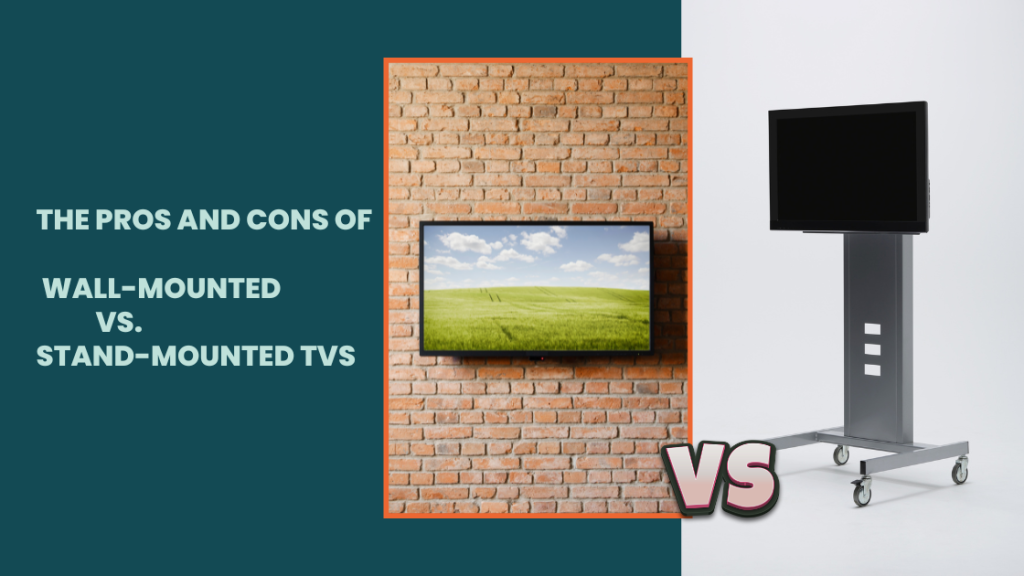If you’re setting up a new television at home, one of the biggest questions that comes up is whether to mount it on the wall or place it on a stand. Both setups have their perks and drawbacks, and the right choice often depends on your living space, lifestyle, and how big your TV actually is. For anyone wondering about options like how to hang tv in apartment or what kind of setup works best for a big screen, this guide breaks down everything you need to know. And if you’d rather skip the hassle and get help, professional tv mounting services near me can handle the hard work.
Before diving into pros and cons, it’s worth mentioning that placement really matters. The way your TV sits in a room has a huge impact on comfort and style. This Tips for Installing a Wall-Mounted TV guide is a helpful resource to understand the right height and positioning, especially before you commit to either mounting or standing your TV.
Why Wall-Mounted TVs Are Popular
Wall mounting has become the go-to choice for many people, especially with today’s slim designs and lightweight flat screens. For renters figuring out mounting tv in apartment or homeowners with a dedicated media wall, wall mounting creates that sleek, modern vibe. It saves floor space, eliminates bulky furniture, and lets you highlight your screen as the main attraction.
A big plus for wall setups is the versatility. Whether you’re working with a tv wall mount for large tv or a heavy tv wall mount, the right bracket gives you flexibility in adjusting angles or pulling the screen away from the wall. Mounts like a wide tv mount or even an extra wide tv mount work especially well for bigger screens, making sure everything stays supported. For those who like an adjustable setup, a tv monitor wall mount or even a clamp mount for tv adds extra movement.
Downsides of Wall Mounting
As great as it looks, there are drawbacks. For starters, figuring out how to hang tv on wall in apartment isn’t always simple. Some landlords don’t allow drilling into walls, and even if they do, you need to make sure your wall can handle the weight. An apartment safe tv mount might be your best option if you’re renting, but even then, installation can be tricky if you don’t have the right tools.
Another drawback is the effort. A big tv wall mount or a heavy tv wall mount isn’t something you want to attempt alone. Getting the bracket level, hitting the studs correctly, and hiding cables takes planning and usually an extra pair of hands. If you’re not careful with wall mount support, you could risk damaging both your wall and your expensive television.
Why TV Stands Still Work
TV stands might not be as trendy as wall mounting, but they come with their own set of advantages. If you’re in a rental and asking, can you wall mount in apartment rules at all, a stand avoids the headache of drilling. You just unpack, set up, and plug in. Stands also give you storage space for consoles, streaming boxes, and soundbars, something you don’t always get with a wall-mounted setup.
For those with very large screens, sometimes it just feels safer. A tv wall mount for large tv can support the weight, but not everyone feels comfortable with a large tv wall installation. A sturdy stand can hold even massive screens without worrying about whether the wall can take it.
Drawbacks of TV Stands
The biggest downside of stands is space. A stand takes up valuable floor area, which can make small apartments feel cramped. If you’re working with a slim living room, the extra bulk might throw off the whole layout. There’s also the safety concern: if you don’t secure the TV, there’s always the risk of it tipping over, especially with kids or pets around.
Another limitation is positioning. Unlike a sliding television mount or a tv on rails, a stand keeps the TV fixed in one place. You can’t tilt it downward or swivel it easily to reduce glare or adjust your view.
Balancing Looks and Function
Choosing between mounting and standing really comes down to how you use your space. If you love the clean look of a floating screen and want to maximize space, wall mounting is the clear winner. Just make sure you invest in a good wall mount support and consider calling in professional help for safe installation. On the other hand, if you value flexibility, extra storage, or live in a rental where wall drilling isn’t allowed, a stand may be the smarter option.
Final Thoughts
At the end of the day, both setups can work beautifully if done right. If you’re deciding between the two, think about your room size, your lease agreement, and how you actually watch TV. For apartment dwellers, options like an apartment safe tv mount or stand might save you stress when moving out. For homeowners, a sleek tv monitor wall mount setup with hidden cables could be the perfect upgrade.
Whichever you choose, the important part is to do it safely and make sure your television is secure. If the idea of tackling a big tv wall mount sounds overwhelming, tv mounting services near me can get the job done quickly and neatly. Pair that with smart placement tips from a TV height guide and you’ll end up with a setup that’s stylish, safe, and perfectly suited to your home.



